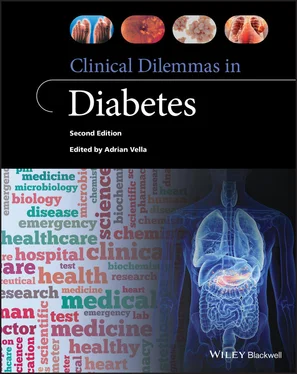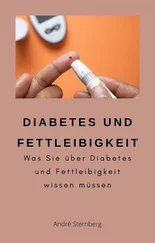HbA1c, FPG, and 2‐h PG during a 75‐g OGTT have different sensitivities and specificities in the diagnosis of prediabetes and DM [39]. An analysis of NHANES data from 2005–2010 examined adults without self‐reported DM at baseline with available measurements for HbA1c, FPG, and 2‐h PG [40]. Prediabetes and DM were defined according to the current ADA Guidelines [1]. Using HbA1c thresholds of ≥ 6.5% for DM and ≥ 5.7% for prediabetes resulted in low sensitivity (24.9% and 35.4%, respectively) and high specificity in identifying patients diagnosed with FPG and 2‐h PG. When FPG and HbA1c were used together for diagnosis, the false‐negative rate was 45.7% for DM and 9.2% for prediabetes.
Similar findings were reported in the Insulin Resistance Atherosclerosis Study (IRAS), which examined 855 subjects and defined DM and prediabetes in accordance with the 2020 ADA Guidelines ( Tables 1.1and 1.2) [1, 41]. HbA1c ≥ 6.5%, FPG ≥ 126 mg/dL, and 2‐h PG ≥ 200 mg/dL identified 32.3%, 44.8%, and 86.8% of individuals with DM, respectively. The combination of HbA1c ≥ 6.5% and/or FPG ≥ 126 mg/dL detected 52.2% of all individuals with DM. HbA1c between 5.7–6.4%, FPG between 100–125 mg/dL, and 2‐h PG between 140–199 mg/dL identified 23.6%, 69.1%, and 59.5% of all non‐diabetic subjects with prediabetes. The combination of HbA1c 5.7–6.4% and/or FPG 100–125 mg/dL detected 75.6% of all non‐diabetic subjects with prediabetes.
TABLE 1.1 The sensitivity of various indices of glycemia used to diagnose type 2 diabetes mellitus in the Insulin Resistance Atherosclerosis Study. Diabetes mellitus was defined according to the 2020 American Diabetes Association criteria. This data illustrates that omitting an oral glucose tolerance test leads to under‐diagnosis of diabetes mellitus, even when both fasting plasma glucose and hemoglobin A1c are measured concurrently. HbA1c = Hemoglobin A1c. FPG = Fasting Plasma Glucose. 2‐h PG = 2‐hour Plasma Glucose [41].
|
Sensitivity |
| HbA1c ≥ 6.5% |
32.3% |
| FPG ≥ 126 mg/dL |
44.8% |
| 2‐h PG ≥ 200 mg/dL |
86.8% |
| HbA1c ≥ 6.5% and/or FPG ≥ 126 mg/dL |
52.2% |
| FPG ≥ 126 mg/dL and/or 2‐h PG ≥ 200 mg/dL |
97.1% |
TABLE 1.2 The sensitivity of various indices of glycemia used to diagnose prediabetes in the Insulin Resistance Atherosclerosis Study. Prediabetes was defined according to the 2020 American Diabetes Association criteria. This data illustrates that omitting an oral glucose tolerance test leads to under‐diagnosis of prediabetes, even when both fasting plasma glucose and hemoglobin A1c are measured concurrently. HbA1c = Hemoglobin A1c. FPG = Fasting Plasma Glucose. 2‐h PG = 2‐hour Plasma Glucose [41].
|
Sensitivity |
| HbA1c 5.7–6.4% |
23.6% |
| FPG 100–125 mg/dL |
69.1% |
| 2‐h PG 140–199 mg/dL |
59.5% |
| HbA1c 5.7–6.4% and/or FPG 100–125 mg/dL |
75.6% |
| FPG 100–125 mg/dL and/or 2‐h PG 140–199 mg/dL |
95.8% |
Despite the limitations of the OGTT – including lower reproducibility and reduced patient convenience compared to FPG and HbA1c – the aforementioned studies suggest that the OGTT continues to have a role in clinical practice. An individual eating three daily meals will be in a postprandial state for 6–9 hours per day [42]. Therefore, it is logical that the knowledge gained from a standardized glucose load is clinically informative. The 2020 ADA Guidelines state that FPG, 2‐h PG during a 75‐g OGTT, and HbA1c are equally appropriate to test for prediabetes and DM [1]. Many clinicians screen with both a FPG and HbA1c. However, the omission of an OGTT leads to a significant under‐diagnosis of both DM and prediabetes.
Risk of progression from prediabetes to diabetes mellitus
The transition from prediabetes to DM2 is variable and influenced by heredity and lifestyle [18, 19, 43]. Multiple variables have been used to estimate the risk of progression to DM2, including glycemic indices, anthropometric data, comorbidities, metabolomics, and genetic variants. Numerous prediction models have been created based on these variables [43–51].
Baseline FPG is a significant predictor of an individual's risk for developing DM [43]. In nondiabetic adults residing in Minnesota, baseline FPG levels < 100 mg/dL, 100–109 mg/dL, and 110–125 mg/dL were associated with a 7%, 19%, and 39% risk, respectively, with progression to DM over a median of 9 years. A discrete gradient of risk for progression to DM was also observed among subjects with a baseline FPG < 100 mg/dL.
During a 75‐g OGTT, 30‐minute, 60‐minute, and 120‐minute PG concentrations were all significant predictors for future risk of DM [49, 52]. One‐hour plasma glucose during a 75‐g OGTT has been shown to be a better predictor of future DM than FPG, HbA1c, and PG at 30 minute and 120 minutes during a 75‐g OGTT [50]. In one study, the hazard ratio for the development of DM was 9.5 (7.90–11.43) for those with combined IFG‐IGT at baseline, 4.5 (4.03–5.02) for those with isolated IGT at baseline, and 3.98 (3.16–5.02) for those with isolated IFG at baseline [45].
Baseline HbA1c is also a strong predictor for risk of future DM, and the risk of incident DM significantly increased across the HbA1c range of 5.0–6.5% [46]. A systematic review found that the 5‐year incidence of DM was 25–50%, 9–25%, and 5–9% among those with a baseline HbA1c of 6.0–6.5%, 5.5–6.0%, and 5.0–5.5%, respectively.
Numerous studies have shown that demographic data, anthropometric data, and comorbidities are associated with progression to DM. Factors positively associated with progression to DM include: family history of diabetes, former or active smoking, higher BMI, abdominal obesity, increased waist circumference, hypertension, elevated triglycerides, low HDL cholesterol, and elevated high sensitivity C‐reactive protein [45, 53, 54]. Increasing age has also been shown to be a predictor of DM in some studies.
Metabolomics profiles have been investigated as a tool to estimate the risk of developing DM. Numerous metabolites have been found to be positively and negatively associated with progression to DM [51]. More than 400 distinct genetic signals that affect the risk of developing DM2 have been identified [20, 44]. Polygenic scores have been used to estimate the combined genetic risk for the development of DM.
Microvascular complications associated with prediabetes
Retinopathy
In a large cohort of Pima individuals, the frequency of retinopathy – defined as the presence of at least one hemorrhage, one microaneurysm, or proliferative retinopathy – was directly related to baseline FPG and 2‐h PG [55]. Beginning at a baseline FPG threshold of 6.0–6.4 mmol/L and 2‐h PG threshold of 9.0–10.6 mmol/L, there was a significant increase in period prevalence (10‐year interval) of retinopathy. Additional data from the Pima individuals illustrated that beyond a HbA1c threshold of 6.2% there was a significant increase in the prevalence of retinopathy [12]. Similar glycemic thresholds for an increase in the prevalence of retinopathy were observed in a cross‐sectional study of Egyptians and data from the Third National Health and Nutrition Examination Survey [13, 14]. Additionally, in the Diabetes Prevention Program (DPP), diabetic retinopathy was detected in 7.9% of the subjects with IGT and in 12.6% of the subjects who developed DM [56]. The prevalence of retinopathy is significantly higher in subjects with DM, but retinopathy can develop in subjects with prediabetic range dysglycemia.
Читать дальше












